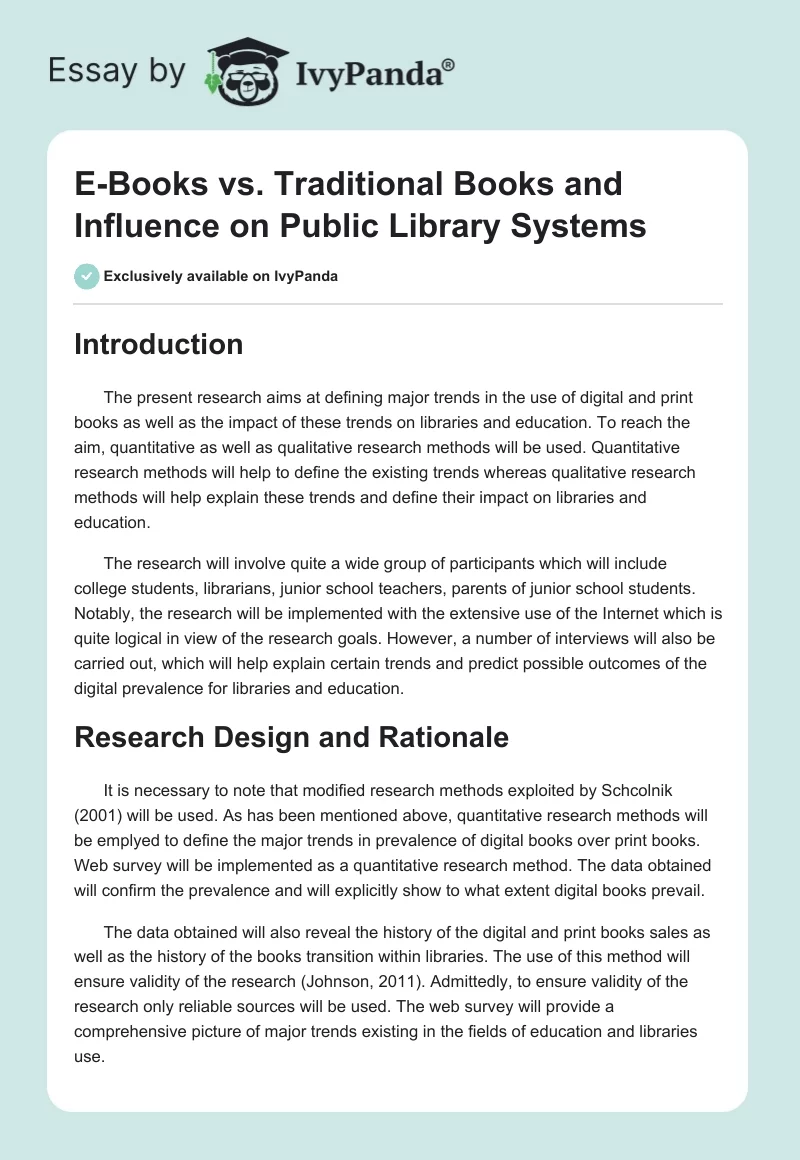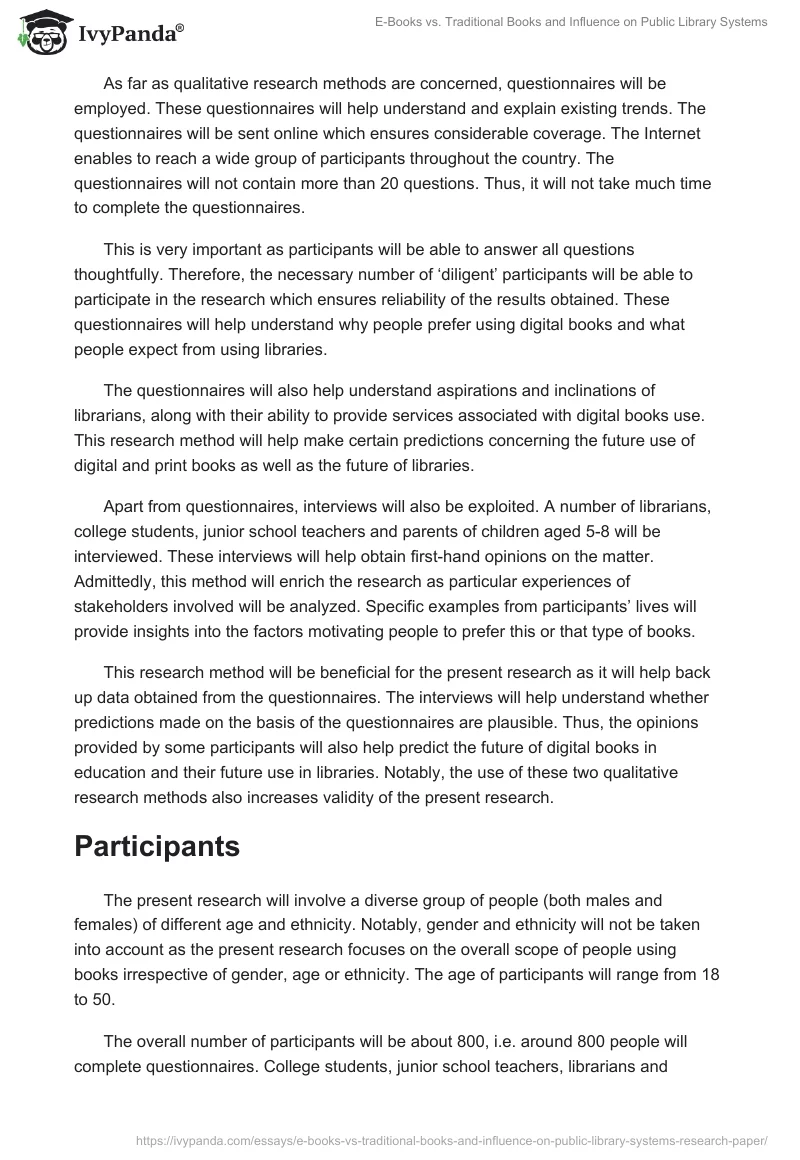Introduction
The present research aims at defining major trends in the use of digital and print books as well as the impact of these trends on libraries and education. To reach the aim, quantitative as well as qualitative research methods will be used. Quantitative research methods will help to define the existing trends whereas qualitative research methods will help explain these trends and define their impact on libraries and education.
The research will involve quite a wide group of participants which will include college students, librarians, junior school teachers, parents of junior school students. Notably, the research will be implemented with the extensive use of the Internet which is quite logical in view of the research goals. However, a number of interviews will also be carried out, which will help explain certain trends and predict possible outcomes of the digital prevalence for libraries and education.
Research Design and Rationale
It is necessary to note that modified research methods exploited by Schcolnik (2001) will be used. As has been mentioned above, quantitative research methods will be emplyed to define the major trends in prevalence of digital books over print books. Web survey will be implemented as a quantitative research method. The data obtained will confirm the prevalence and will explicitly show to what extent digital books prevail.
The data obtained will also reveal the history of the digital and print books sales as well as the history of the books transition within libraries. The use of this method will ensure validity of the research (Johnson, 2011). Admittedly, to ensure validity of the research only reliable sources will be used. The web survey will provide a comprehensive picture of major trends existing in the fields of education and libraries use.
As far as qualitative research methods are concerned, questionnaires will be employed. These questionnaires will help understand and explain existing trends. The questionnaires will be sent online which ensures considerable coverage. The Internet enables to reach a wide group of participants throughout the country. The questionnaires will not contain more than 20 questions. Thus, it will not take much time to complete the questionnaires.
This is very important as participants will be able to answer all questions thoughtfully. Therefore, the necessary number of ‘diligent’ participants will be able to participate in the research which ensures reliability of the results obtained. These questionnaires will help understand why people prefer using digital books and what people expect from using libraries.
The questionnaires will also help understand aspirations and inclinations of librarians, along with their ability to provide services associated with digital books use. This research method will help make certain predictions concerning the future use of digital and print books as well as the future of libraries.
Apart from questionnaires, interviews will also be exploited. A number of librarians, college students, junior school teachers and parents of children aged 5-8 will be interviewed. These interviews will help obtain first-hand opinions on the matter. Admittedly, this method will enrich the research as particular experiences of stakeholders involved will be analyzed. Specific examples from participants’ lives will provide insights into the factors motivating people to prefer this or that type of books.
This research method will be beneficial for the present research as it will help back up data obtained from the questionnaires. The interviews will help understand whether predictions made on the basis of the questionnaires are plausible. Thus, the opinions provided by some participants will also help predict the future of digital books in education and their future use in libraries. Notably, the use of these two qualitative research methods also increases validity of the present research.
Participants
The present research will involve a diverse group of people (both males and females) of different age and ethnicity. Notably, gender and ethnicity will not be taken into account as the present research focuses on the overall scope of people using books irrespective of gender, age or ethnicity. The age of participants will range from 18 to 50.
The overall number of participants will be about 800, i.e. around 800 people will complete questionnaires. College students, junior school teachers, librarians and parents of children aged 5-8 will be involved. These will be representatives of different colleges, schools and libraries. No less than ten colleges, ten schools and ten libraries will be involved in the present research as this kind of diversity can ensure validity of the research.
About 16 participants (4 college students, 4 junior school teachers, 4 librarians and 4 parents of children aged 5-8) will be interviewed. The participants will be invited after the questionnaires are analyzed. The half of the interviewees (2 college students, 2 junior school teachers, 2 librarians and 2 parents of children aged 5-8) will be those who prefer using digital books and the other half will be people who prefer print books (2 college students, 2 junior school teachers, 2 librarians and 2 parents of children aged 5-8).
Development of the Research Tool
The web survey is the first stage of the research. Governmental websites providing statistics and digital archives from the libraries will be extracted and analyzed. These sources ensure validity of the data obtained (Johnson, 2011). As far as the governmental websites are concerned, these resources will help obtain data on the amount of produced and sold digital books as well as print books.
The number of libraries and the rates of the enrollment to these libraries can also be found at such websites. Data of some poles and surveys are also available at such websites. Libraries’ digital archives will provide more specific information on the amount of print and digital books in each library, transition of books within each library, the number of people enrolled and the list of services provided.
As for the questionnaires, they will include personal data of participants (age, education, occupation) as well as questions concerning the use of digital and print books and attitude toward libraries. Each group of participants will get a particular questionnaire (i.e. there will be four types of questionnaires).
These data will help understand the role digital and print books play in college and junior education. The data will also help understand the role these books play in the system of US libraries. Apart from this, the data obtained will help define aspirations of people involved which, in its turn, will help make predictions as for the future of digital and print books in libraries and in education.
College students will answer questions concerning their preferences in reading and using libraries, types of literature they read using print and digital books, types of services they receive and would like to receive in libraries. Junior school teachers will have questions concerning the use of digital and print books in their classrooms and their interactions with librarians.
Parents will answer questions concerning their children and their participation in their children’s literacy development. The parents will also answer whether they use digital or print books while encouraging their children to read. Finally, librarians will answer the questions concerning their work with digital and print books. Their preferences as well as their skills will be defined with the help of the questionnaires.
The interviews are aimed at obtaining more detailed information which is backed up by real life experiences. The interviews will have similar questions as the questionnaires (though, not the same) but they will contain open questions (Johnson, 2011). This will help deeper understand preferences, aspirations and inclinations of the stakeholders involved. Thus, real life stories and opinions will help predict the future of the books and libraries.
Summary of the Chapter
The present chapter dwells upon the methodology used to carry out the present research. Combination of quantitative and qualitative research method ensures reliability and validity of the research. Web survey, questionnaires and interviews will be exploited. Validity of the web survey will ensure the sources used, i.e. governmental websites, libraries’ digital archives.
The research will involve about 800 participants (college students, junior school teachers, librarians and parents of children aged 5-8) who will be representatives of different colleges, junior schools and libraries. Questionnaires and interviews will contain questions concerning participants’ preferences, habits, skills and aspirations. It is possible to note that the number of participants and the variety of the research methods used will ensure informativity and validity of the present research.
Reference List
Johnson, A.P. (2011). Short guide to action research. New York, NY: Addison Wesley.
Schcolnik, M. (2001). A study of reading with dedicated e-readers. (Unpublished doctoral dissertation). Nova Southeastern University. Web.


